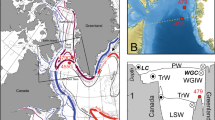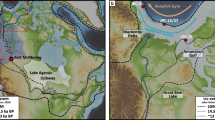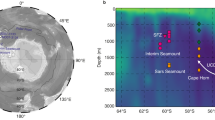Abstract
ROOTH1 proposed that the Younger Dryas cold episode, which chilled the North Atlantic region from 11,000 to 10,000 yr BP, was initiated by a diversion of meltwater from the Mississippi drainage to the St Lawrence drainage system. The link between these events is postulated to be a turnoff, during the Younger Dryas cold episode, of the North Atlantic's conveyor-belt circulation system which currently supplies an enormous amount of heat to the atmosphere over the North Atlantic region2. This turnoff is attributed to a reduction in surface-water salinity, and hence also in density, of the waters in the region where North Atlantic Deep Water (NADW) now forms. Here we present oxygen isotope and accelerator radiocarbon measurements on planktonic foraminifera from Orca Basin core EN32-PC4 which reveal a significant reduction in meltwater flow through the Mississippi River to the Gulf of Mexico from about 11,200 to 10,000 radiocarbon years ago. This finding is consistent with the record for Lake Agassiz which indicates that the meltwater from the southwestern margin of the Laurentide Ice Sheet was diverted to the northern Atlantic Ocean through the St Lawrence valley during the interval from ~11,000 to 10,000 years before present (yr BP).
This is a preview of subscription content, access via your institution
Access options
Subscribe to this journal
Receive 51 print issues and online access
$199.00 per year
only $3.90 per issue
Buy this article
- Purchase on Springer Link
- Instant access to full article PDF
Prices may be subject to local taxes which are calculated during checkout
Similar content being viewed by others
References
Rooth, C. Prog. Oceanogr. 11, 131–149 (1982).
Broecker, W. S., Peteet, D. & Rind, D. Nature 315, 21–25, 1985).
Teller, J. T. & Clayton, L. in Glacial Lake Agassiz, Spec. pap. 26 (Geological Association of Canada, Ottawa, 1983).
Teller, J. T. in The Late Quaternary Development of the Champlain Sea Basin, Spec. pap. 35, 281–289 (Geological Association of Canada, Ottawa, 1988).
Teller, J. T. & Thorleifson, L. H. in Glacial Lake Aggasiz, Spec. pap. 26, 261–290 (Geological Association of Canada, Ottawa, 1983).
Clayton, L. & Moran, S. R. Quat. Sci. Rev. 1, 55–82 (1982).
Moran, S. R., Clayton, L., Scott, M. & Brophy, J. North Dakota Geol. Survey Miscellaneous Ser. 53 (North Dakota Geological Survey, Pierre, 1973).
Teller, J. T. Geological Report GR80-4 (Manitoba Mineral Resources Division, Winnipeg, 1980).
Drexler, C. W., Farrand, W. & Hughes, J. in Glacial Lake Agassiz, Spec. pap. 26, 309–329 (Geological Association of Canada, Ottawa, 1983).
Clayton, L. in Glacial Lake Agassiz, Spec. pap. 26, 291–307 (Geological Association of Canada, Ottawa, 1983).
Arndt, B. M. Rep. of Investigation No. 60 (North Dakota Geological Survey, Pierre, 1977).
Kennett, J. P. & Shackleton, N. J. Science 188, 147–150 (1975).
Emiliani, C. et al. Science 189, 1083–1088 (1975).
Leventer, A., Williams, D. F. & Kennett, J. P. Earth planet. Sci. Lett. 59, 11–17 (1982).
Leventer, A., Williams, D. F. & Kennett, J. P. Mar. Geol. 53, 23–40 (1983).
Kennett, J. P. & Penrose, N. L. Nature 276, 172–173 (1978).
Kennett, J. P., Elmstrom, K. & Penrose, N. Palaeogeogr. Palaeoclimatol. Palaeoecol. 50, 189–216 (1985).
Broecker, W. S. et al. Paleoceanography 3, 1–19 (1988).
Be, A. W. H. Micropaleontology 6, 373–392 (1960).
Tolderlund, D. S. & Be, A. W. H. Micropaleontology 17, 297–329 (1971).
Rind, D., Peteet, D., Broecker, W., Mclntyre, A. & Ruddiman, W. Clim. Dyn. 1, 3–33 (1986).
Dyke, A. S. & Prest, V. K. Geogr. phys. Quat. 41, 237–263 (1987).
Teller, J. T. in Quaternary Evolution of the Great Lakes, Spec. pap. 30, 1–16 (Geological Association of Canada, Ottawa, 1985).
Teller, J. T. in Geology of North America vol. K-3 (eds Ruddiman, W. F. and Wright, H. E.) (Geological Society of America, Boulder, 1987).
Duplessy, J.-C., Delibrias, G., Turon, G., Pujol, C. & Duprat, J. Palaeogeogr. Palaeoclimatol. Palaeoecol. 35, 121–144 (1981).
Fairbanks, R. G. Nature (in the press).
Boyle, E. A. & Keigwin, L. Nature 330, 35–40 (1987).
Rind, D., Peteet, D., Broecker, W., Mclntyre, A. & Ruddiman, W. Clim. Dyn. 1, 3–33 (1986).
Author information
Authors and Affiliations
Rights and permissions
About this article
Cite this article
Broecker, W., Kennett, J., Flower, B. et al. Routing of meltwater from the Laurentide Ice Sheet during the Younger Dryas cold episode. Nature 341, 318–321 (1989). https://doi.org/10.1038/341318a0
Received:
Accepted:
Issue Date:
DOI: https://doi.org/10.1038/341318a0
This article is cited by
-
Into the Holocene, anatomy of the Younger Dryas cold reversal and preboreal oscillation
Scientific Reports (2024)
-
1-km resolution rebound surfaces and paleotopography of glaciated North America since the Last Glacial Maximum
Scientific Data (2023)
-
RETRACTED ARTICLE: Catastrophic flood outbursts in mid-continent left imprints in the Gulf of Mexico
Geo-Marine Letters (2023)
-
Arctic drainage of Laurentide Ice Sheet meltwater throughout the past 14,700 years
Communications Earth & Environment (2022)
-
Composition, Source and Environmental Indication of Clay Minerals in Sediments from Mud Deposits in he Southern Weihai Offshore, Northwestern Shelf of the South Yellow Sea, China
Journal of Ocean University of China (2022)
Comments
By submitting a comment you agree to abide by our Terms and Community Guidelines. If you find something abusive or that does not comply with our terms or guidelines please flag it as inappropriate.



